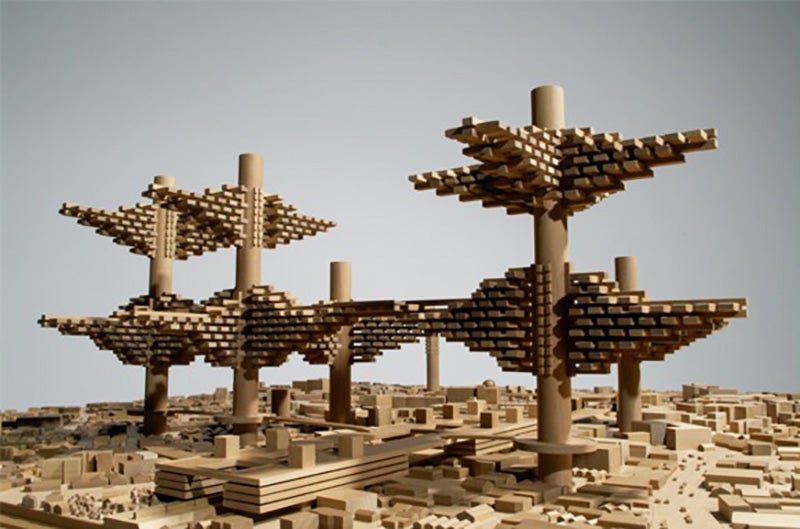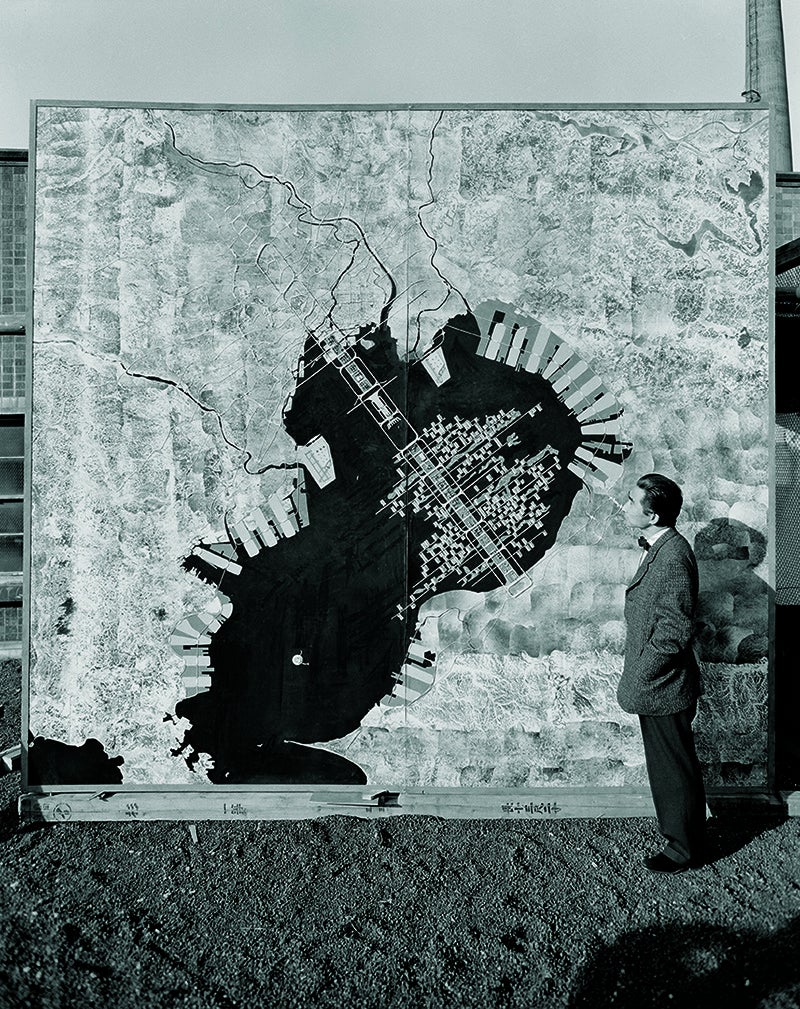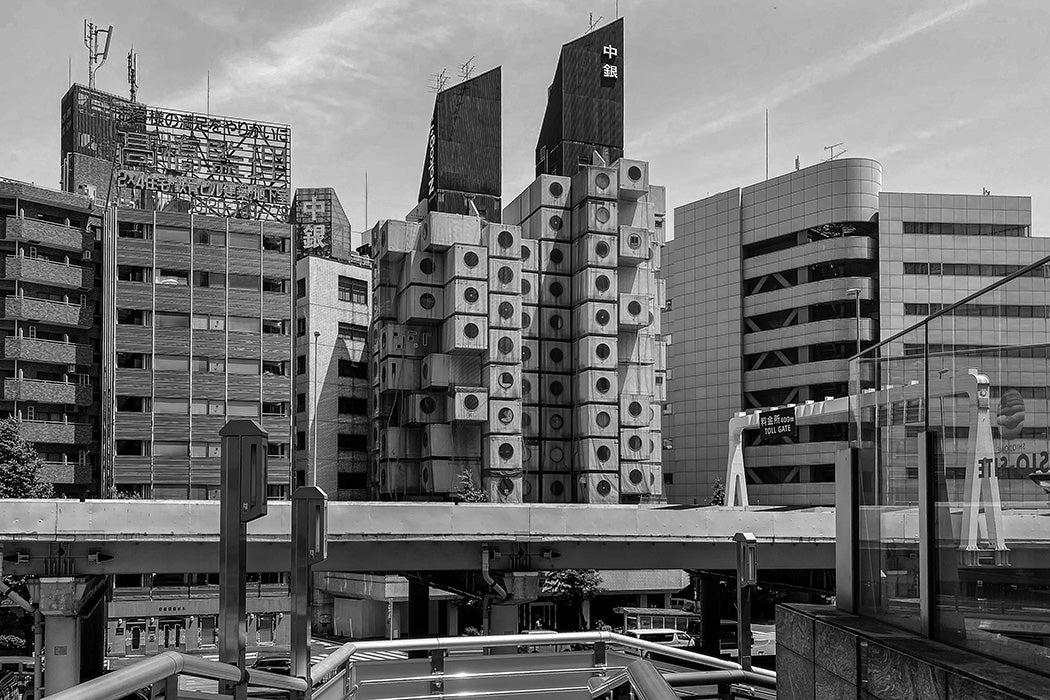The demolition of the Kisho Kurokawa’s Nakagin Capsule Tower in Tokyo came as a bit of a shock when it began earlier this year. Sure, rumors of its imminent dismantling had been circulating since at least 2007. But did any of us really think that the day would actually come? For many, the Nakagin Capsule Tower is regarded as the prime example of Metabolist architecture. It’s an icon. Now, its ultimate demise brings about a time of reflection. But how should we reflect on Metabolism’s legacy?
The Metabolists, a group of visionary architects, designers, and architectural critics, emerged in Japan after World War II, an era in which the country grappled with its defeat in the context of an evolving global economy and intensifying Cold War. Made “official” with the publication of the Metabolism manifesto in May 1960, the group sought to develop architecture that it considered “organic.” As architectural historian Ken Tadashi Oshima explains, the designers were attempting to address
the broad challenge of reconstructing Japan after World War II through a dynamic, organic approach to urban and architectural infrastructure in which colossal platforms, pyramids, and helixes could embrace short-term, replaceable plug-in elements.
The Metabolists wanted an architecture that would respond to the changing needs of a city over time. As the urban fabric evolved, buildings and infrastructure needed to be adaptable enough to evolve with it. They understood that rigidness in design and construction was a building’s downfall. Themes of flexibility and evolution became hallmarks of Metabolist design and urban planning.
Arata Isozaki’s City in the Air, Kisho Kurokawa’s Nakagin Capsule Tower, and Kenzo Tange’s Tokyo Bay Plan all exemplify the Metabolist approach, though only Kurokawa was a formal member of the group. Historians consider both Isozaki and Tange a part of the “Metabolist Nexus” that often worked with and supported Metabolist theories, notes Oshima. In their designs, one sees the intended adaptability of architecture to change as Tokyo changed around it.

For instance, Kurokawa’s Nakagin Capsule Tower popularized the capsule architecture now so distinctive to Japan. The building had two central cores, into which plugged individual capsule units. This “plug-in” feature was intended to give capsule owners the option to upgrade and switch out old capsules for new ones as their lifestyles and needed changed. Unfortunately, this aspect of the design was never realized.

Many of the Metabolists envisioned architecture over the water and into the sky. These were open spaces free of the spatial limitations imposed by existing structures. In the sky or over the water, a building was not forced to stop where the land did. Kenzo Tange’s Tokyo Bay Plan proposed an expansion of buildable space across Tokyo Bay by using a combination of pilotis and reclaimed land. In parallel, Arata’s City in the Sky explored the possibilities of megastructures with massive central cores that would rise above the existing urban fabric. The freedom of the sky would allow buildings to rise up and then out, and, once high above the city, horizontal arms could hold and connect a series of capsules to complete the structure.
In designing in isolation from the existing built environment, Arata was also sharing a criticism of Metabolism, however. “Looking at the activities of the Metabolists,” he explained in 2014, “to my way of thinking the somehow made architecture and the city incoherent and disconnected.”
Many Metabolist designs did exist in isolation, creating a new system for building that didn’t connect with what already existed, as if building an isolated city within a city. So, while City in the Air showed the possibilities of Metabolist thinking, it also showed its problems.
Despite the limitations of Metabolism, the movement’s primary and ancillary practitioners gained “almost legendary status in architecture,” writes Oshima. So, it may be difficult to understand the demolition of Kurokawa’s iconic Nakagin Capsule Tower. The demolition of architecturally significant buildings in Japan is not new, however, and the situation of the Nakagin Capsule Tower is not unique. Scholar and practitioner of urbanism Zhongjie Lin reminds us that Western ideas of preservation are different from those in Japan.
Weekly Newsletter
The Ise Shrine is a good example of this. This Shinto shrine has existed in Japan since at least the seventh century, but only because it’s rebuilt every twenty years. While the shrine may seem like a permanent fixture within Japanese culture, it only exists through architectural impermanence. This idea of impermanence—a flexible approach to architecture that sought new ways to allow the built environment to serve the needs of a culture—in part inspired Metabolist ideas. Cities will continue to evolve and change as living organisms, making adjustments and adding new buildings as needed, just as envisioned by the Metabolists.
So, what about the Nakagin Capsule Tower? Well, while architecture tourists will no longer be able to search out Kurokawa’s design in Tokyo’s Ginza neighborhood, only to be greeted with signs stating that the building is not open to the public, it will remain a historic icon that reflects the possibilities of Metabolist architecture, if only on paper.
Support JSTOR Daily! Join our new membership program on Patreon today.







